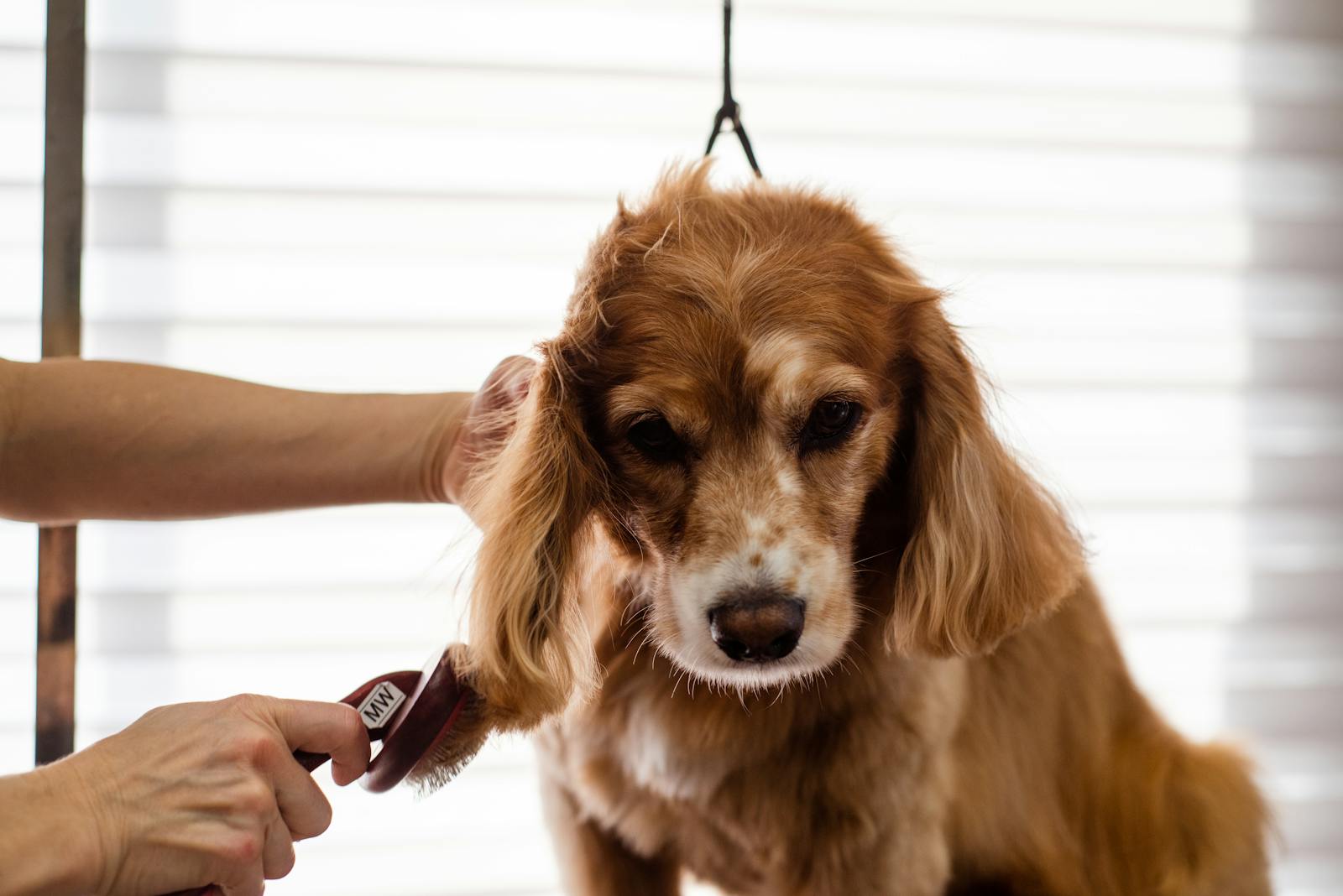Dog Grooming: Tips and Tricks for a Clean and Happy Pup
Dog grooming is an essential aspect of responsible pet ownership. It involves the maintenance of your dog’s hygiene and appearance through various grooming techniques such as bathing, brushing, trimming, and nail care. Regular grooming sessions not only keep your dog looking and smelling good but also contribute to their overall health and well-being.
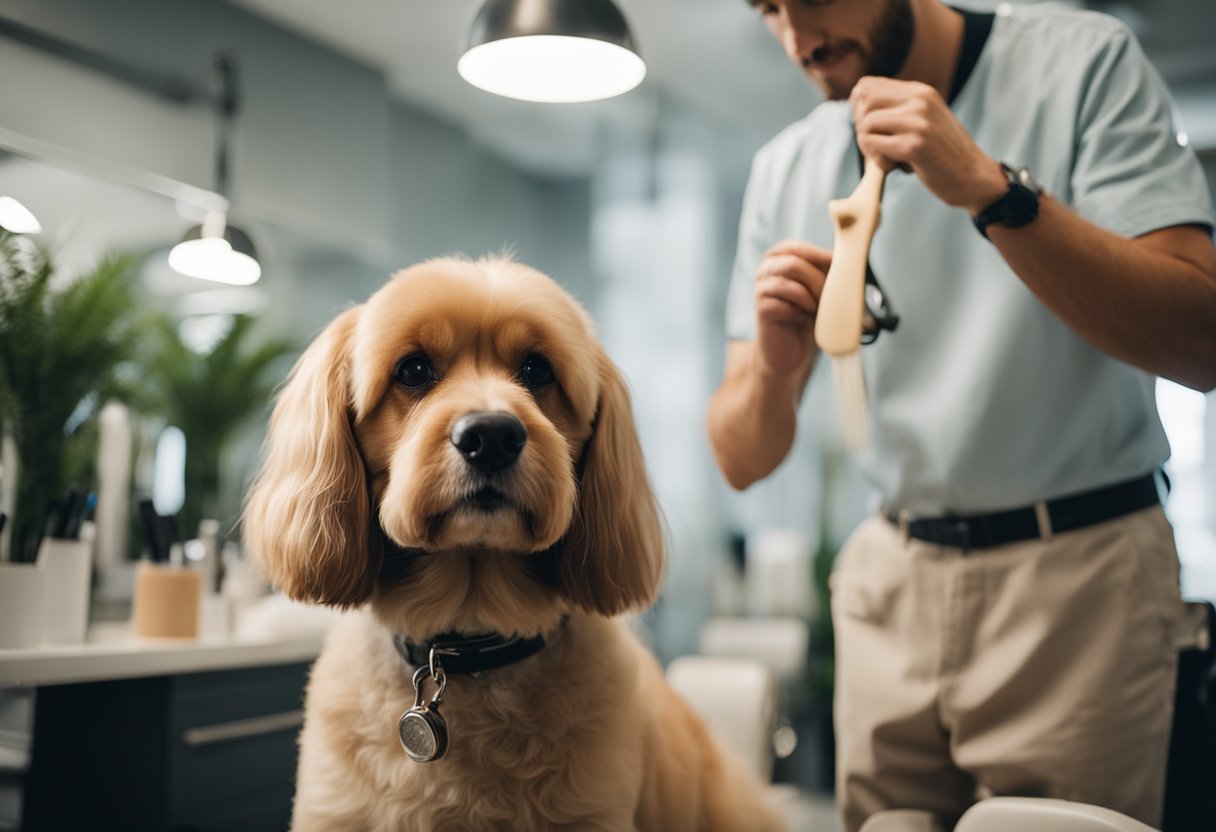
Understanding dog grooming is important to ensure that you are providing the best care for your furry friend. It involves not only the physical aspects of grooming but also the psychological and emotional aspects of the grooming experience. By understanding your dog’s needs and preferences, you can tailor your grooming routine to suit their individual requirements and make the experience as enjoyable as possible.
Key Takeaways
- Dog grooming is a crucial part of responsible pet ownership that involves maintaining your dog’s hygiene and appearance.
- Understanding your dog’s needs and preferences is important to tailor your grooming routine to suit their individual requirements.
- Regular grooming sessions not only keep your dog looking and smelling good but also contribute to their overall health and well-being.
Understanding Dog Grooming
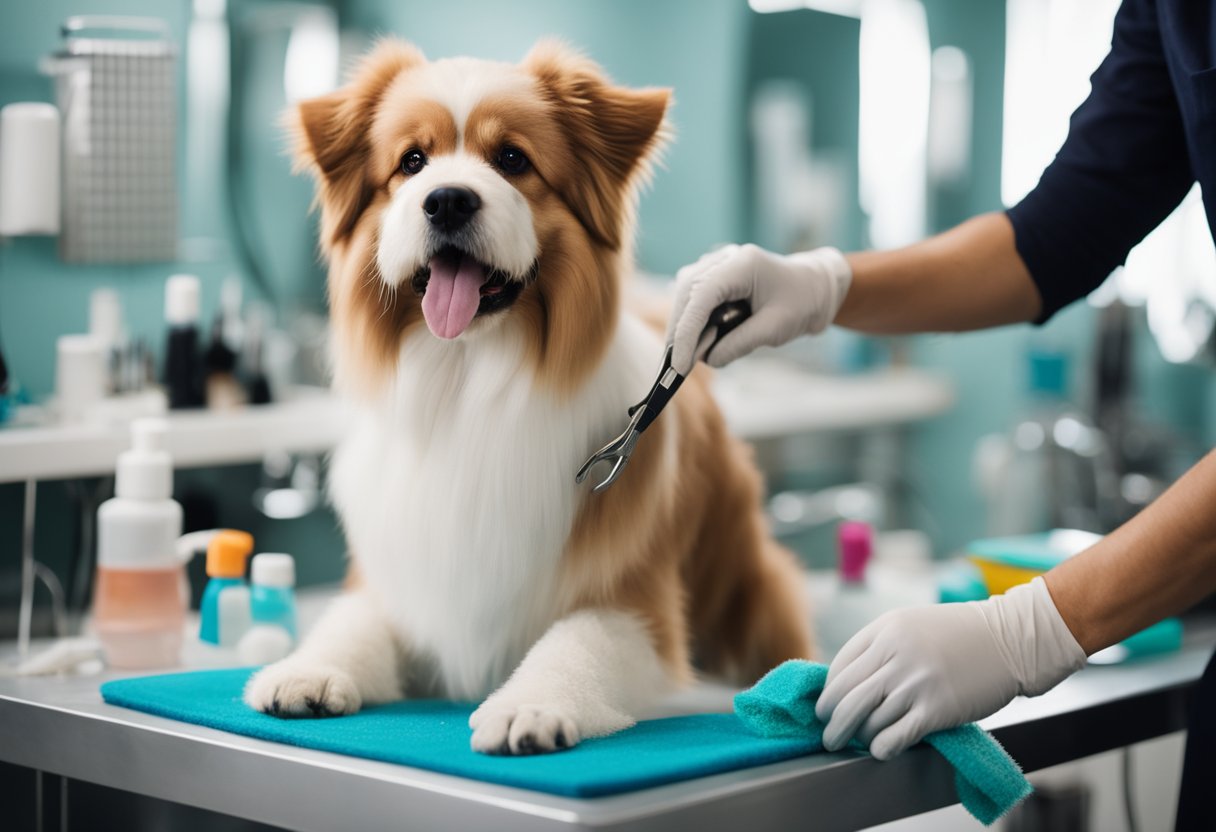
Dog grooming is an essential part of responsible dog ownership. It involves the various tasks associated with keeping your dog clean, healthy, and looking their best. Regular grooming can also help you detect any health issues early on, such as skin irritations or lumps.
When it comes to dog grooming, there are several different tasks you should be aware of. These include:
- Bathing: Depending on your dog’s breed and lifestyle, you may need to bathe them every few weeks or only occasionally. Use a dog-specific shampoo and conditioner, and be sure to rinse thoroughly to avoid any skin irritation.
- Brushing: Regular brushing helps remove loose hair, dirt, and debris from your dog’s coat. It can also distribute natural oils and prevent matting.
- Nail trimming: Keeping your dog’s nails trimmed is important for their comfort and health. Long nails can cause pain and discomfort when walking or running.
- Ear cleaning: Regular ear cleaning can help prevent infections and keep your dog’s ears healthy.
- Teeth cleaning: Just like humans, dogs need their teeth cleaned regularly to prevent dental issues. Use a dog-specific toothbrush and toothpaste.
It’s important to note that different breeds may have different grooming needs. For example, dogs with long hair may need more frequent brushing to prevent matting, while short-haired dogs may need less frequent brushing. Always consult with your veterinarian or a professional groomer for breed-specific grooming advice.
Overall, dog grooming is an important part of keeping your furry friend healthy and happy. By incorporating regular grooming tasks into your routine, you can help prevent health issues and keep your dog looking their best.
Essential Dog Grooming Tools
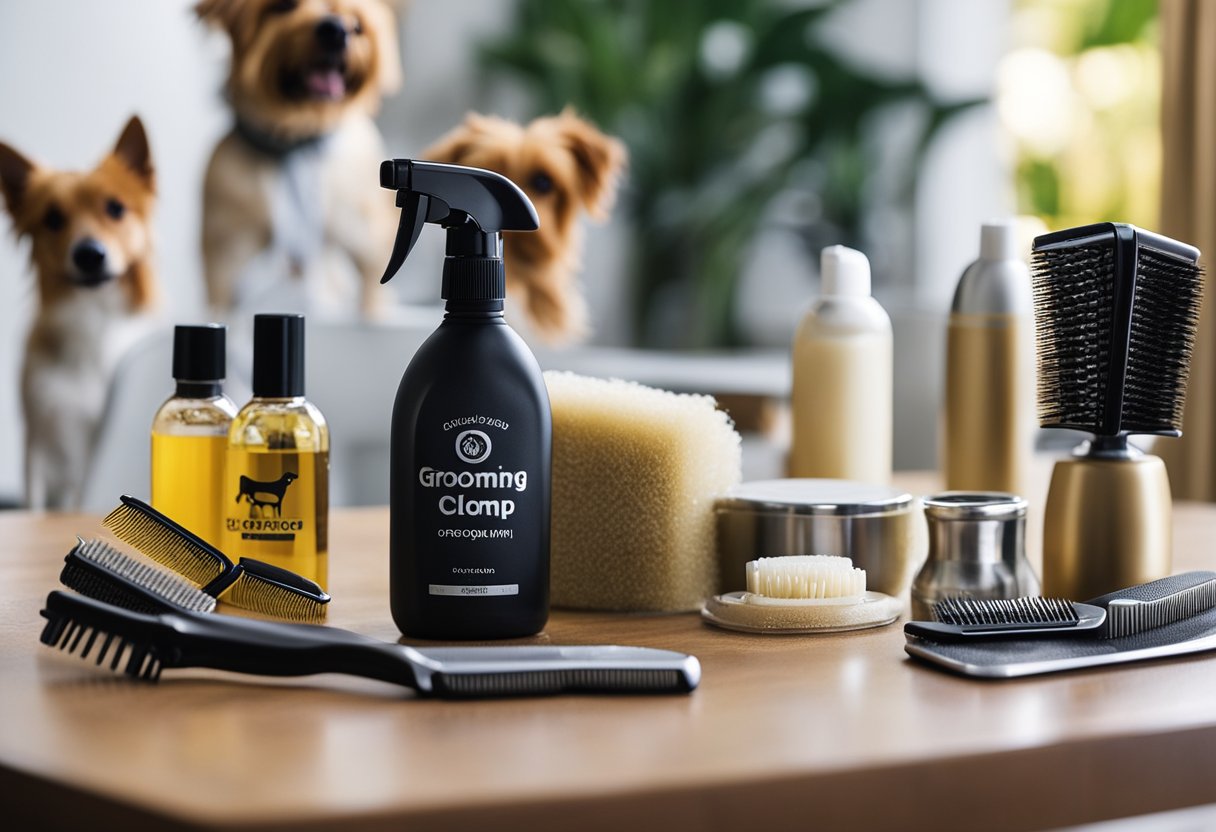
Taking care of your furry friend’s grooming needs is an essential part of being a responsible pet owner. In order to keep your dog looking and feeling their best, you’ll need to have the right tools on hand. Here are some of the essential grooming tools you’ll need to get started:
Brushes and Combs
Brushes and combs are essential for keeping your dog’s coat looking healthy and shiny. Different types of brushes and combs are designed for different types of coats, so it’s important to choose the right ones for your dog. For example, a slicker brush is great for removing tangles and mats from long-haired breeds, while a pin brush is better for short-haired breeds. A comb is also essential for removing any leftover tangles or mats and for checking for fleas and ticks.
Clippers and Scissors
If you plan on giving your dog a haircut, you’ll need a good pair of clippers and scissors. Clippers are great for trimming large areas of fur, while scissors are better for precision work around the face and paws. Make sure to choose clippers that are specifically designed for dogs, as human clippers can be too powerful and can cause injury.
Shampoos and Conditioners
Regular bathing is important for keeping your dog’s coat clean and healthy. When choosing a shampoo and conditioner, make sure to choose products that are specifically designed for dogs. Human products can be too harsh for your dog’s sensitive skin and can cause irritation. Look for products that are made with natural ingredients and are free of harsh chemicals.
Grooming Tables
A grooming table can make the grooming process much easier and more comfortable for both you and your dog. These tables are designed to keep your dog in place and at a comfortable height, so you can easily reach all areas of their body. Grooming tables come in a variety of sizes and styles, so make sure to choose one that is appropriate for your dog’s size and breed.
By having these essential grooming tools on hand, you’ll be able to keep your dog looking and feeling their best. Remember to choose the right tools for your dog’s specific needs and to always follow proper grooming techniques to ensure a safe and comfortable experience for both you and your furry friend.
Preparing Your Dog for Grooming
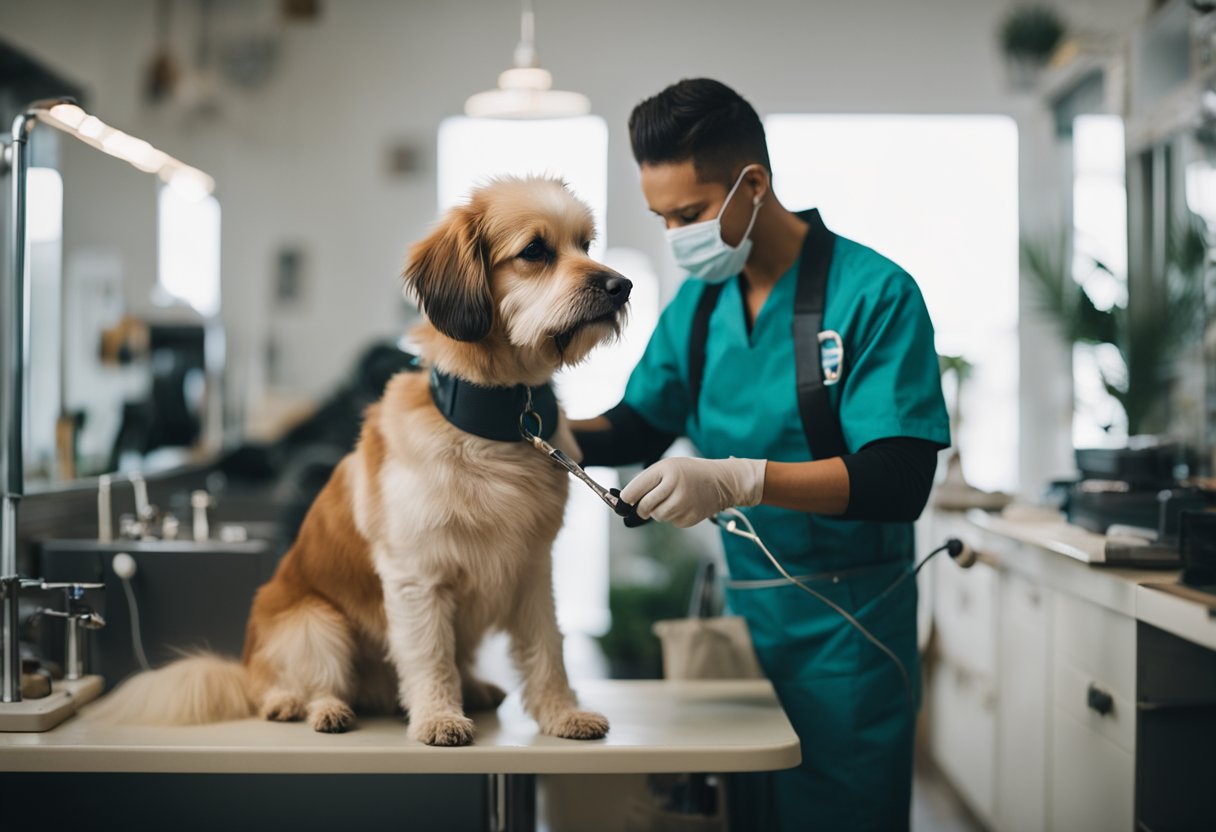
Grooming is an essential part of maintaining your dog’s health and appearance. However, the grooming process can be stressful for some dogs, especially those who are not used to being handled or have had bad grooming experiences in the past. To make the grooming experience more comfortable for your furry friend, you can take some steps to prepare them beforehand.
Calming Techniques
Before grooming your dog, it is important to help them relax. You can use calming techniques such as massage, aromatherapy, and music to soothe your dog’s nerves. Massaging your dog’s ears, neck, and shoulders can help release tension and promote relaxation. You can also use lavender or chamomile essential oils to help calm your dog. Playing soft and calming music in the background can also help create a relaxing atmosphere.
Handling Different Dog Temperaments
Different dogs have different temperaments, and some may be more difficult to groom than others. It is important to understand your dog’s personality and work with them accordingly. For example, if your dog is nervous or anxious, you may need to take extra time to help them relax before starting the grooming process. If your dog is aggressive or fearful, it may be best to seek professional help from a certified dog groomer or animal behaviorist.
When grooming your dog, it is important to be patient, gentle, and understanding. Use positive reinforcement techniques such as treats and praise to reinforce good behavior. Avoid using force, punishment, or negative reinforcement methods, as these can cause your dog to become fearful or aggressive.
By taking the time to prepare your dog for grooming and using calming techniques and positive reinforcement, you can help make the grooming experience more enjoyable for your furry friend.
Bathing Techniques
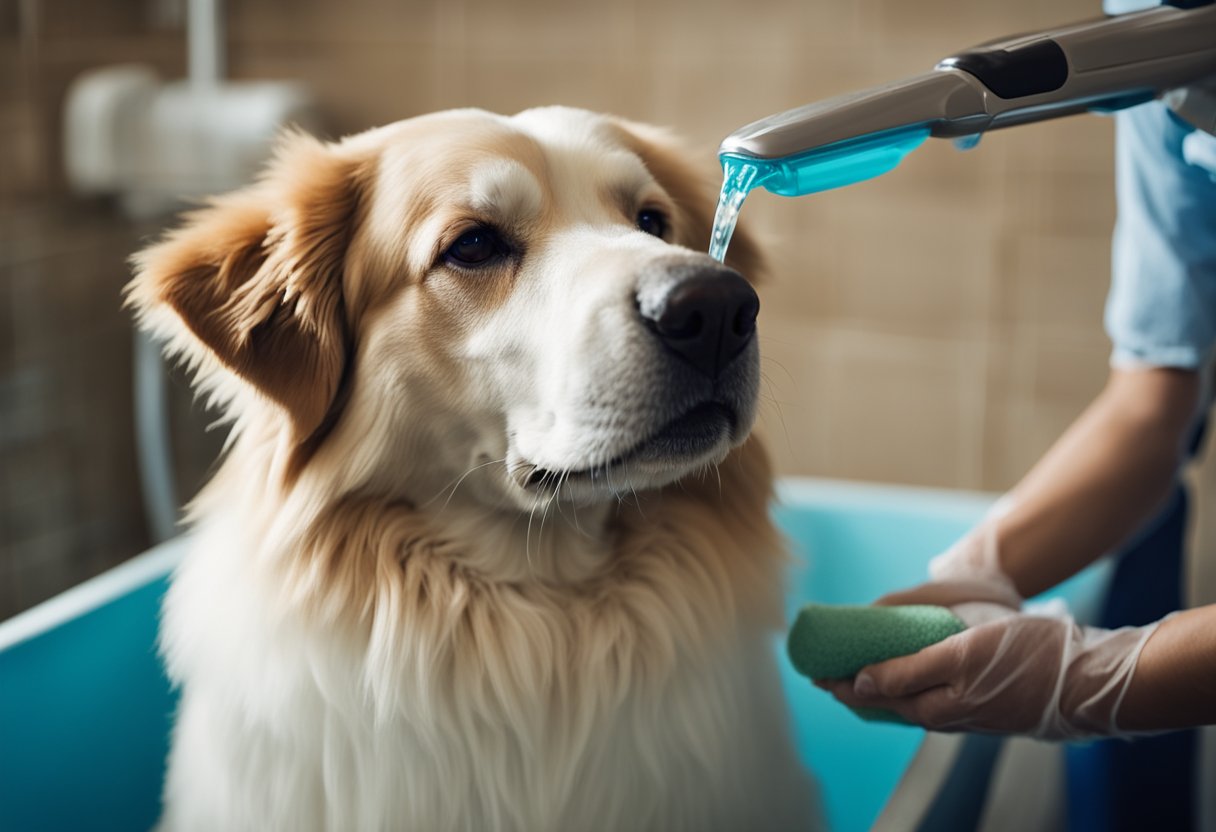
Bathing your dog is an essential part of their grooming routine. It helps to keep them clean, healthy, and smelling fresh. In this section, we will cover the best techniques for bathing your dog.
Bath Frequency
The frequency of bathing your dog depends on their breed, coat type, and lifestyle. Some dogs require more frequent baths than others. For example, dogs that spend a lot of time outdoors or have skin conditions may need to be bathed more often. On the other hand, dogs with oily coats may need to be bathed less frequently.
As a general rule, most dogs should be bathed every 3 months. However, if your dog gets dirty or smelly before then, it’s okay to give them a bath. Over-bathing can strip their coat of natural oils and cause dry skin.
Proper Rinsing and Drying
Proper rinsing and drying are essential for your dog’s skin and coat health. Leftover soap can irritate their skin and cause bacterial growth. Here are some tips for proper rinsing and drying:
- Use warm water to rinse your dog thoroughly. Cold water can be uncomfortable for them.
- Make sure to rinse all the soap from their coat, including their paws, face, and ears.
- Dry your dog thoroughly with a towel or blow dryer on a low setting. Leaving them damp can cause skin irritation and fungal growth.
By following these techniques, you can ensure that your dog’s bath is effective and safe. Remember to choose the right shampoo for your dog’s coat type and always rinse and dry them thoroughly.
Brushing and Combing
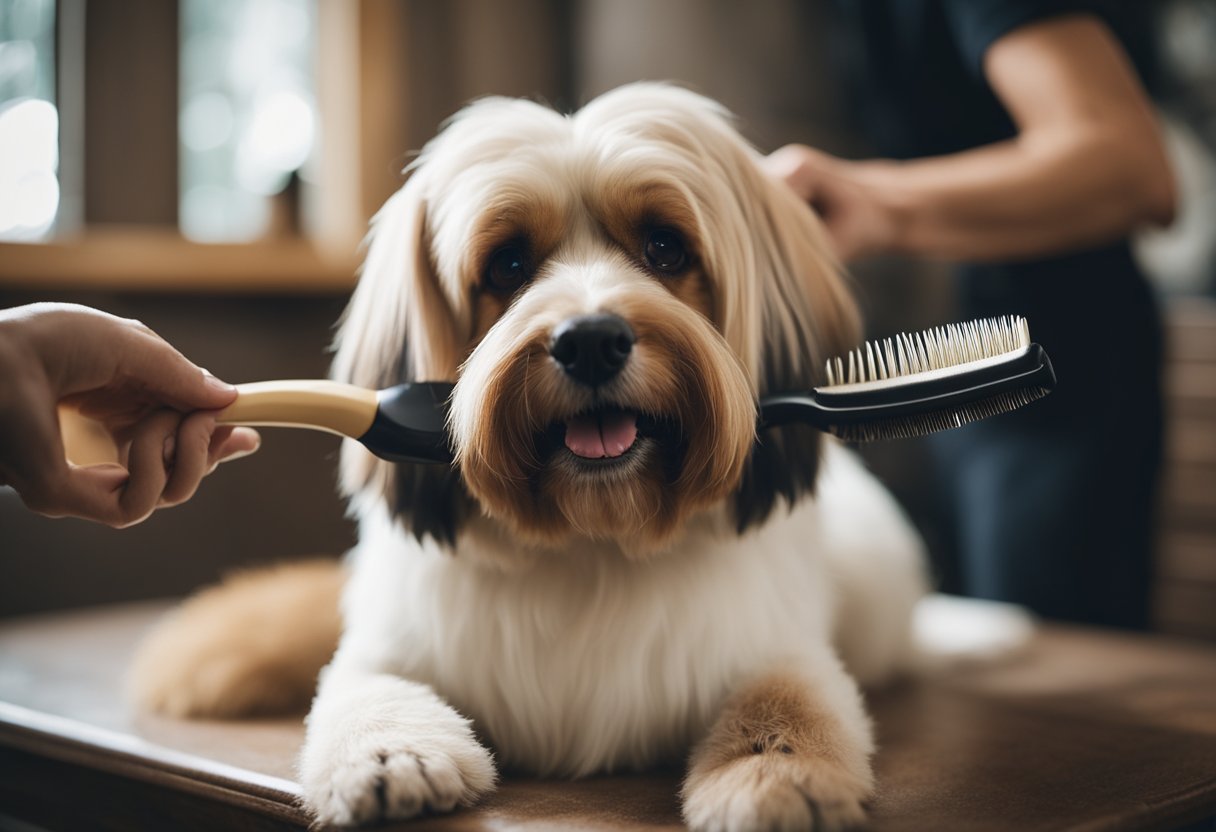
Brushing and combing your dog’s fur is an essential part of their grooming routine. Not only does it keep their coat looking shiny and healthy, but it also helps prevent matting and tangles. In this section, we will discuss two important aspects of brushing and combing: detangling fur and preventing matting.
Detangling Fur
Detangling your dog’s fur is crucial to maintaining a healthy coat. If you neglect to detangle your dog’s fur, it can lead to painful matting and even skin irritation. To detangle your dog’s fur, you will need a slicker brush and a comb.
- Start by using the slicker brush to gently work out any tangles or knots in your dog’s fur. Be sure to brush in the direction of hair growth and use short, gentle strokes.
- Once you have worked out any tangles, use a comb to go over your dog’s fur and remove any remaining knots.
- Repeat this process until your dog’s fur is completely detangled.
Preventing Matting
Preventing matting is key to keeping your dog’s coat healthy and happy. Here are some tips to help prevent matting:
- Brush your dog’s fur regularly. The frequency of brushing will depend on your dog’s breed and coat type, but as a general rule, you should aim to brush your dog at least once a week.
- Use a slicker brush to remove any loose fur and prevent tangles.
- Pay special attention to areas where matting is most likely to occur, such as behind the ears, under the legs, and around the tail.
- If you notice any matting, use a comb to gently work out the knot. If the matting is severe, you may need to use scissors to carefully cut it out.
By following these tips, you can help keep your dog’s coat healthy and mat-free. Remember, regular brushing and combing is key to maintaining a healthy and happy pup!
Hair Trimming and Styling

Keeping your dog’s coat neat and tidy not only makes them look good, but it also helps maintain their overall health and hygiene. Hair trimming and styling are an essential part of dog grooming, and it’s crucial to know the right techniques and tools to use.
Breed-Specific Cuts
Different dog breeds have different coat types and styles, which require specific cuts. For instance, Bichon Frises have a fluffy, curly coat that requires regular trimming to prevent matting. They can be styled in various ways, such as the Kennel Cut, Teddy Bear Cut, Breed Trim, or Show Groom. PlayBarkRun provides an excellent resource for understanding the various breed-specific cuts and styles.
Cockapoos, on the other hand, have a wavy or curly coat that requires regular brushing and trimming to prevent matting. While there is no official breed trim for Cockapoos, they can be styled in a long (Teddy Bear) or short (Kennel Cut) trim. PlayBarkRun provides an excellent resource for understanding the various breed-specific cuts and styles.
Safety Tips
Hair trimming and styling can be risky if done improperly. Here are some safety tips to keep in mind:
- Use the right tools: Always use sharp, high-quality scissors and clippers designed for pet grooming. Dull tools can pull and tug at your dog’s hair, causing pain and discomfort.
- Be cautious around sensitive areas: Be extra careful when trimming hair around your dog’s eyes, ears, and genitals. These areas are sensitive and require a gentle touch.
- Use a calm and reassuring tone: Dogs can sense your emotions, so it’s essential to remain calm and reassuring during the grooming process. Speak in a soothing tone and offer treats and praise to keep your dog relaxed.
- Take breaks: Grooming can be tiring for both you and your dog. Take breaks every few minutes to give your dog a chance to rest and rehydrate.
By following these tips and understanding the breed-specific cuts and styles, you can keep your dog’s coat looking neat and tidy while maintaining their overall health and well-being.
Nail Care
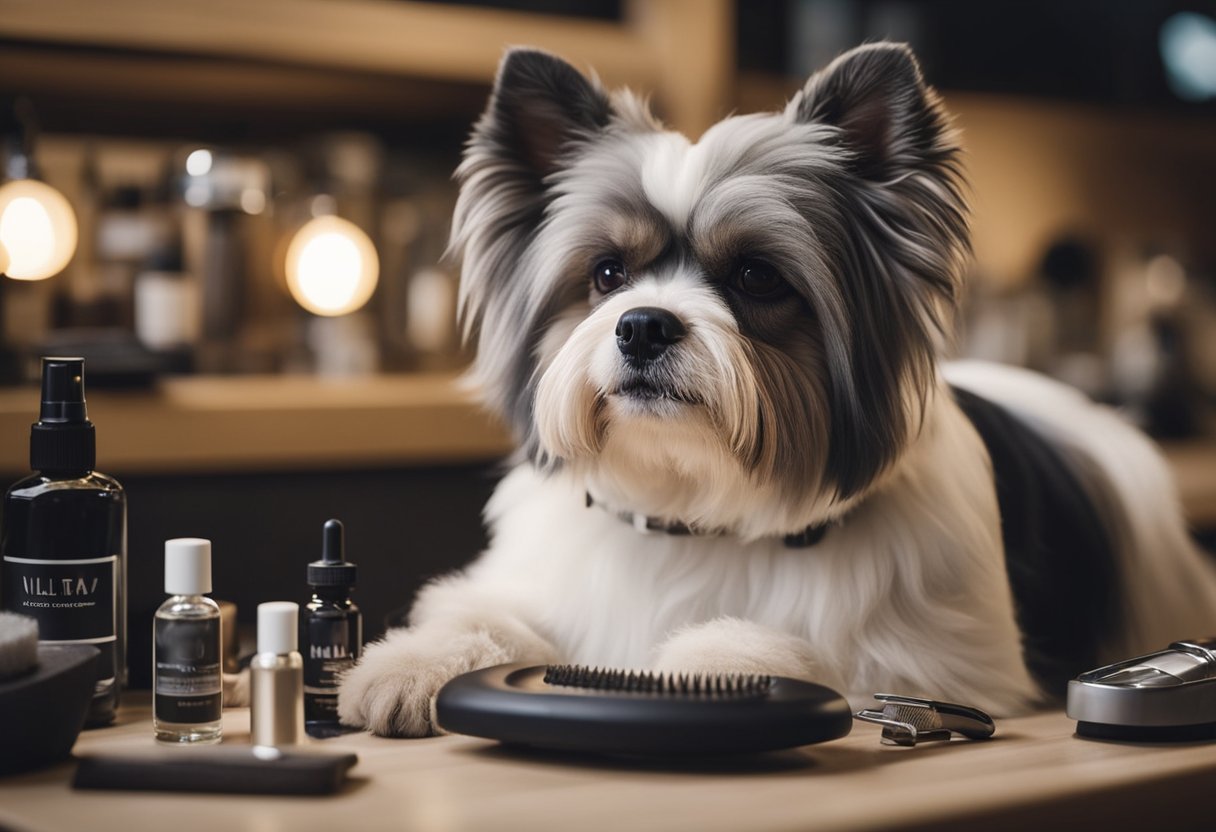
One important aspect of dog grooming is nail care. Keeping your dog’s nails trimmed is essential for their health and comfort. Long nails can cause discomfort and even pain when walking, and can lead to joint problems over time. In this section, we will cover the basics of nail care, including trimming nails and avoiding injuries.
Trimming Nails
Trimming your dog’s nails can be a daunting task, but with the right tools and technique, it can be done easily and safely. It is important to use clippers specifically designed for dog nails, as human nail clippers can cause injury.
To trim your dog’s nails, start by holding their paw firmly and locating the quick, which is the pink area of the nail that contains blood vessels and nerves. It is important to avoid cutting the quick, as it can cause bleeding and pain. If your dog has clear nails, you can easily see the quick. If their nails are dark, use caution and trim small amounts at a time.
When trimming, use a steady hand and make smooth cuts. If you accidentally cut the quick, use styptic powder or cornstarch to stop the bleeding. Reward your dog with treats and praise throughout the process to make it a positive experience.
Avoiding Injuries
While trimming your dog’s nails, it is important to avoid injuring them. In addition to avoiding the quick, be sure to avoid cutting too close to the skin, as it can cause pain and infection.
If your dog has long or curved nails, consider using a nail grinder instead of clippers. A grinder can round the edges of the nail and prevent sharp points that can scratch you or your furniture.
Regular nail trimming can prevent injuries and keep your dog healthy and comfortable. If you are unsure about how to trim your dog’s nails, consult with a professional groomer or veterinarian for guidance.
Ear and Eye Care
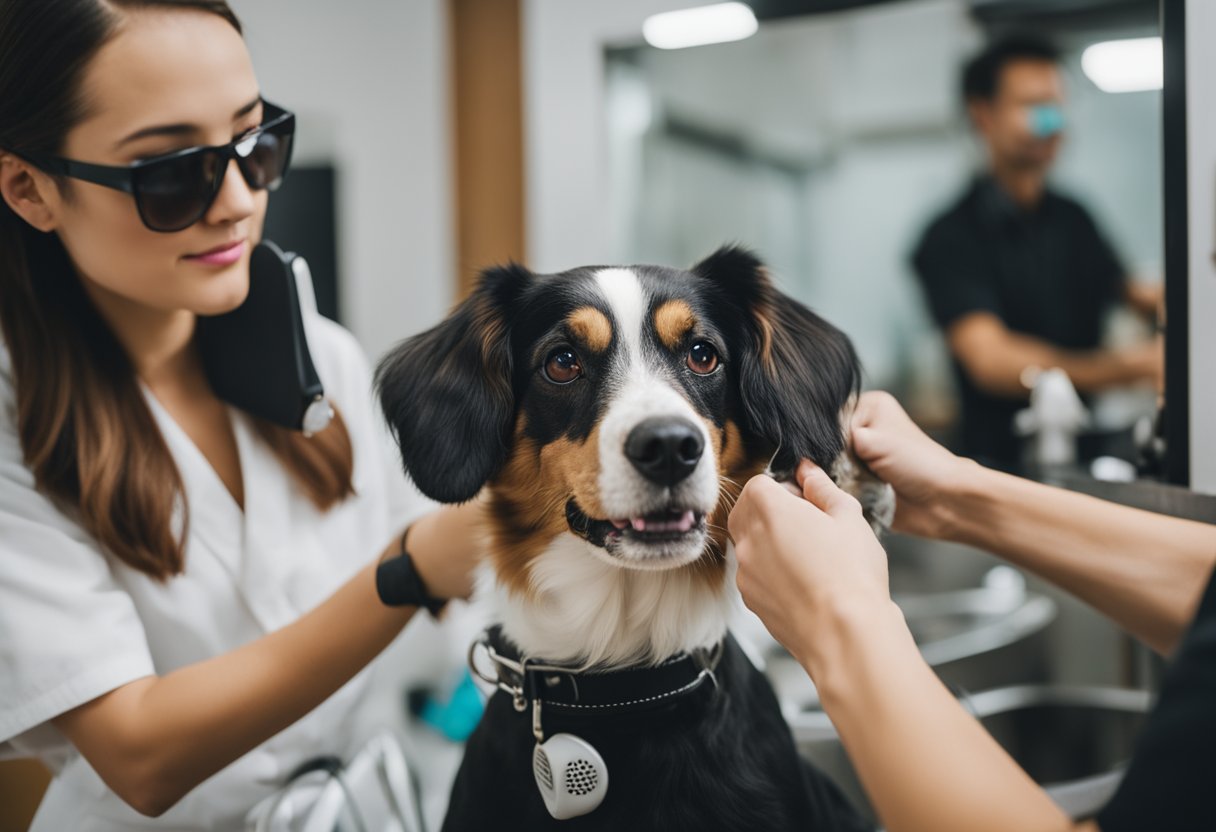
Taking care of your dog’s ears and eyes is an essential part of their grooming routine. Regular cleaning and maintenance can help prevent infections and other health issues. In this section, we will discuss how to clean your dog’s ears and maintain their eyes.
Cleaning Ears
Cleaning your dog’s ears can help prevent infections and other ear-related issues. To clean your dog’s ears, follow these steps:
- Start by inspecting your dog’s ears for any signs of redness, swelling, or discharge. If you notice any of these symptoms, contact your veterinarian.
- Use a cotton ball or a soft cloth to wipe the inside of your dog’s ears. Avoid using cotton swabs, as they can push debris further into the ear canal.
- Apply a few drops of ear cleaning solution to a cotton ball and gently wipe the inside of your dog’s ear. Be sure to follow the instructions on the ear cleaning solution.
- Dry your dog’s ear with a clean, dry cloth.
Eye Maintenance
Maintaining your dog’s eyes is just as important as cleaning their ears. Here are some tips for maintaining your dog’s eyes:
- Inspect your dog’s eyes regularly for any signs of redness, swelling, or discharge. If you notice any of these symptoms, contact your veterinarian.
- Use a damp cloth to gently wipe away any discharge from your dog’s eyes. Be sure to use a separate cloth for each eye to prevent the spread of infection.
- Trim any hair around your dog’s eyes to prevent it from irritating their eyes. Be sure to use blunt scissors or an approved trimmer to avoid injuring your dog.
- Protect your dog’s eyes from the sun and other environmental factors by using dog sunglasses or a dog hat.
By following these tips, you can help keep your dog’s ears and eyes healthy and prevent any potential health issues.
Dental Hygiene
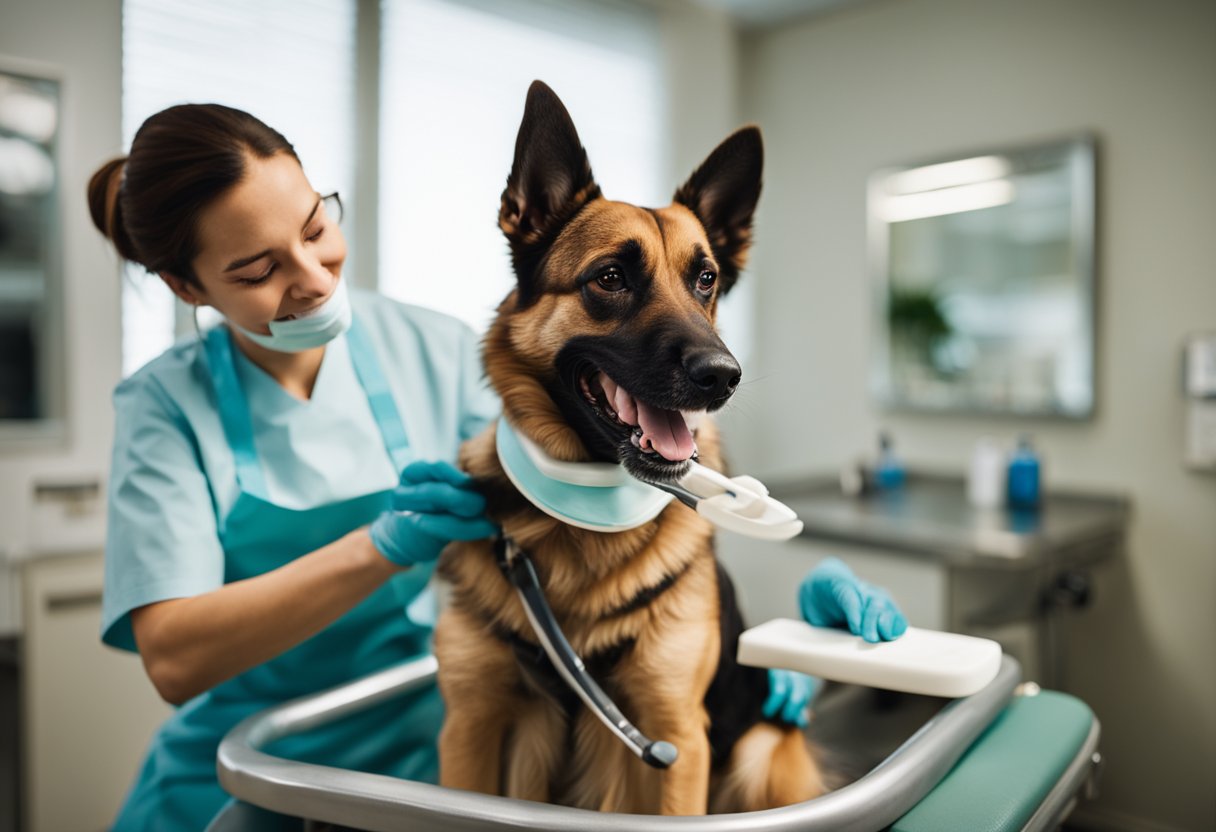
Taking care of your dog’s teeth is an important part of their overall health. Neglecting dental hygiene can lead to tooth decay, gum disease, and bad breath. In this section, we will cover two ways to maintain your dog’s dental hygiene: teeth brushing and dental treats and toys.
Teeth Brushing
Brushing your dog’s teeth is the most effective way to keep their teeth clean and healthy. You should aim to brush your dog’s teeth at least once a week, but ideally, you should brush them daily. Here are the steps to follow when brushing your dog’s teeth:
- Choose a toothbrush that is specifically designed for dogs. You can use a finger brush or a regular toothbrush with soft bristles.
- Use toothpaste that is made for dogs. Human toothpaste can be harmful to dogs.
- Start by letting your dog taste the toothpaste. This will help them get used to the taste and smell.
- Lift your dog’s lip and brush their teeth in a circular motion. Focus on the outside of their teeth, as this is where most periodontal disease progresses.
- Praise and reward your dog for tolerating the brushing.
Dental Treats and Toys
Dental treats and toys can also help maintain your dog’s dental hygiene. These treats and toys are designed to clean your dog’s teeth as they chew and play. Here are some options to consider:
| Treat/Toy | Benefits |
|---|---|
| Rawhide chews | Helps remove plaque and tartar |
| Dental chews | Helps freshen breath and remove plaque |
| Rubber chew toys | Helps clean teeth and massage gums |
| Dental sticks | Helps remove plaque and freshen breath |
When choosing dental treats and toys, make sure to look for options that are appropriate for your dog’s size and chewing habits. Always supervise your dog when they are chewing on toys or treats to prevent choking or swallowing. By incorporating teeth brushing and dental treats and toys into your dog’s routine, you can help keep their teeth clean and healthy.
Health Checks During Grooming
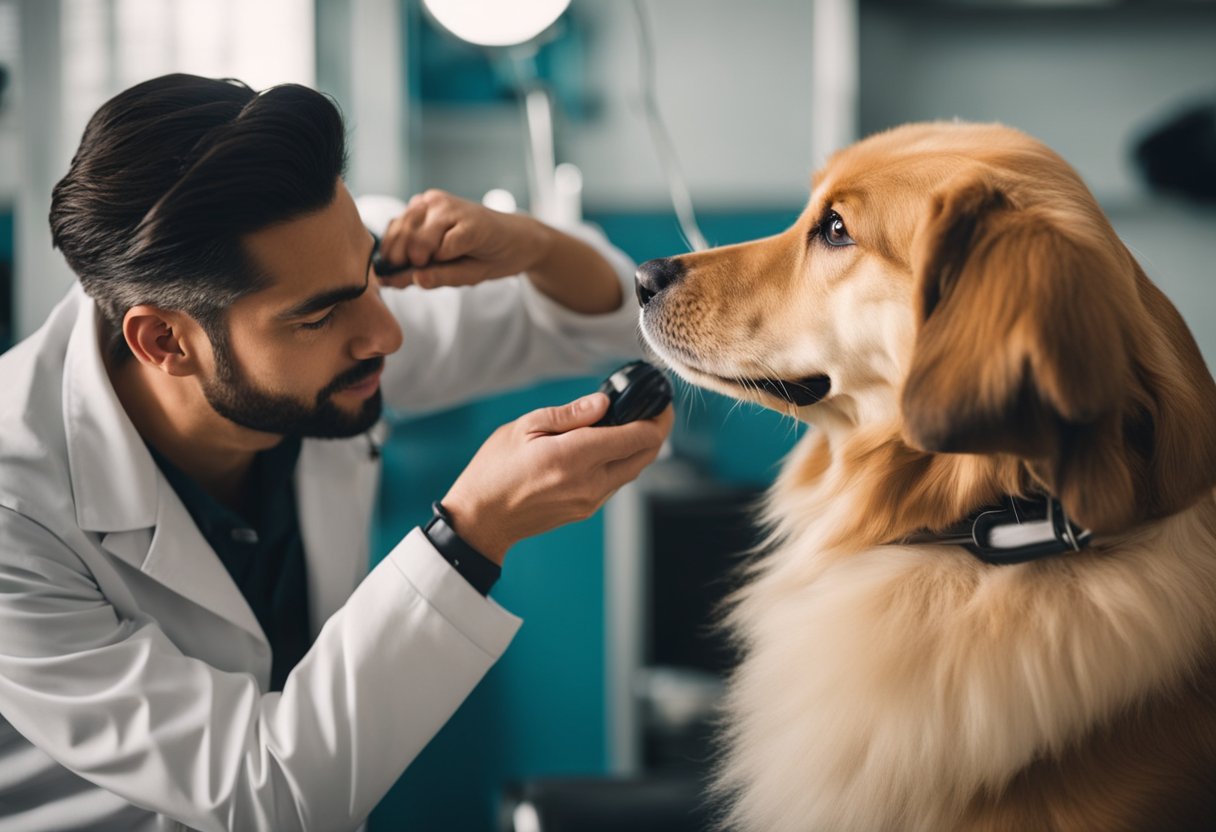
Grooming your dog regularly is an essential part of their overall health and wellbeing. During the grooming process, it’s important to perform health checks to ensure that your dog is healthy and free from any underlying health issues. Here are two critical health checks you should perform during grooming:
Skin and Coat Examination
Your dog’s skin and coat are excellent indicators of their overall health. Regularly examining your dog’s skin and coat can help you detect any potential health problems early on. During grooming, check your dog’s skin for any lumps, bumps, or sores. If you notice any abnormal growths or lesions, consult your veterinarian immediately.
Additionally, examine your dog’s coat for any signs of dryness, flakiness, or excessive shedding. These symptoms can indicate an underlying health issue, such as a nutritional deficiency or skin infection. Make sure to brush your dog’s coat regularly to remove any loose hair and debris.
Parasite Detection
Parasites can cause a variety of health problems for your dog, including skin irritation, anemia, and even death. During grooming, check your dog for any signs of fleas, ticks, or other parasites. Use a fine-toothed comb to check for fleas and ticks, paying close attention to areas such as the ears, neck, and tail.
If you find any parasites, remove them immediately using a flea comb or tweezers. Make sure to dispose of any fleas or ticks properly to prevent reinfestation. Additionally, consider using a monthly flea and tick preventative to protect your dog from future infestations.
Performing regular health checks during grooming can help you detect any potential health problems early on. By keeping your dog healthy and free from parasites, you can ensure that they live a long, happy, and healthy life.
Professional Grooming Services
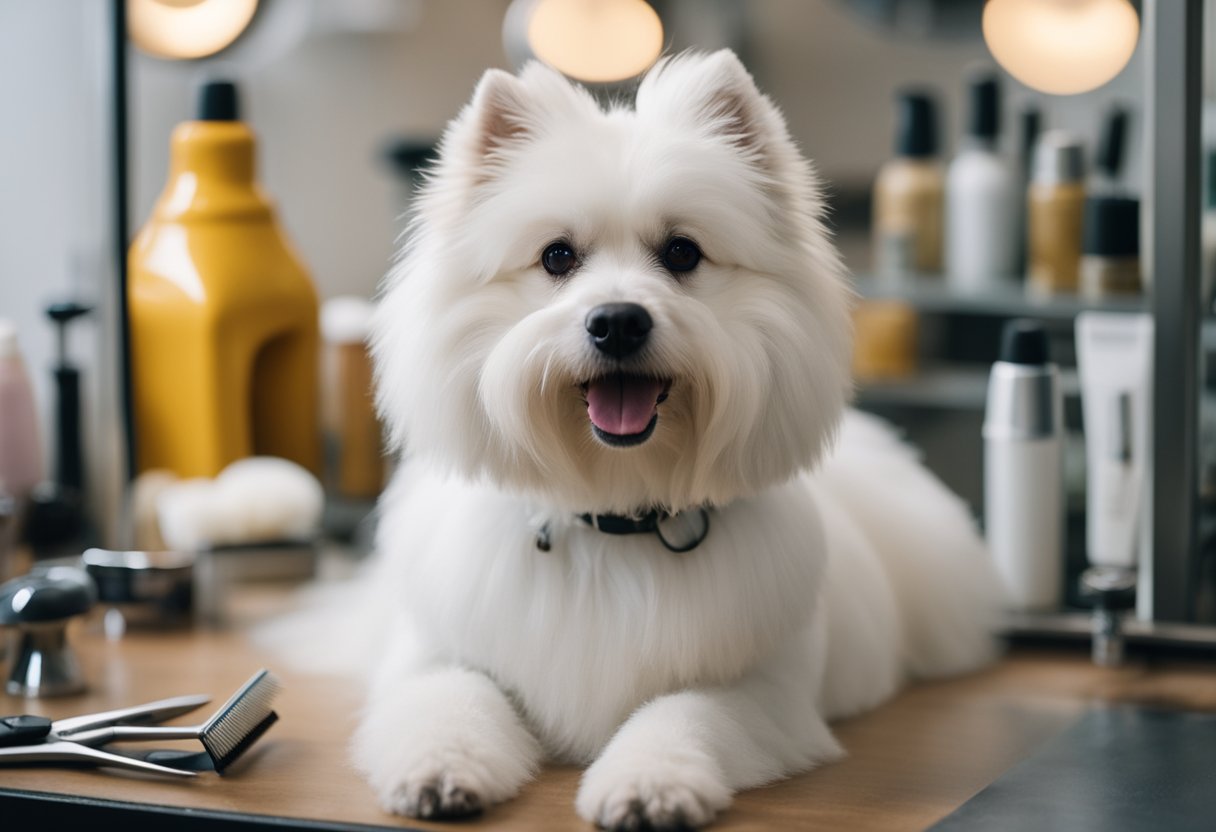
If you want your dog to look and feel their best, professional grooming services might be just what you need. Here are some things to consider when choosing a groomer and the grooming packages they offer.
Choosing a Groomer
When choosing a groomer, you want to make sure they are experienced and knowledgeable in dog grooming. Look for a groomer who has been in business for a while and has good reviews from other dog owners. You can also ask for recommendations from your veterinarian or other dog owners you know.
It’s important to visit the groomer’s facility before you make an appointment. Make sure the facility is clean and well-maintained, and that the staff is friendly and knowledgeable. You can also ask to see the grooming area to make sure it’s safe and comfortable for your dog.
Grooming Packages
Most groomers offer a variety of grooming packages to choose from. Here are some common grooming packages and what they typically include:
- Bath and Brush: This package includes a bath, blow-dry, brush-out, and nail trim. It’s a great option for dogs who need a quick clean-up between haircuts.
- Full Groom: This package includes a bath, blow-dry, brush-out, haircut, and nail trim. It’s a good option for dogs who need a complete grooming session.
- De-Shedding: This package includes a bath, blow-dry, brush-out, and de-shedding treatment. It’s a great option for dogs who shed a lot.
- Puppy Groom: This package includes a bath, brush-out, nail trim, and ear cleaning. It’s a good option for puppies who are new to grooming.
- Senior Groom: This package includes a bath, brush-out, haircut, nail trim, and ear cleaning. It’s a good option for senior dogs who may need extra attention and care.
Overall, professional grooming services can help keep your dog healthy, happy, and looking their best. By choosing the right groomer and grooming package, you can ensure your dog gets the care they need.
Frequently Asked Questions
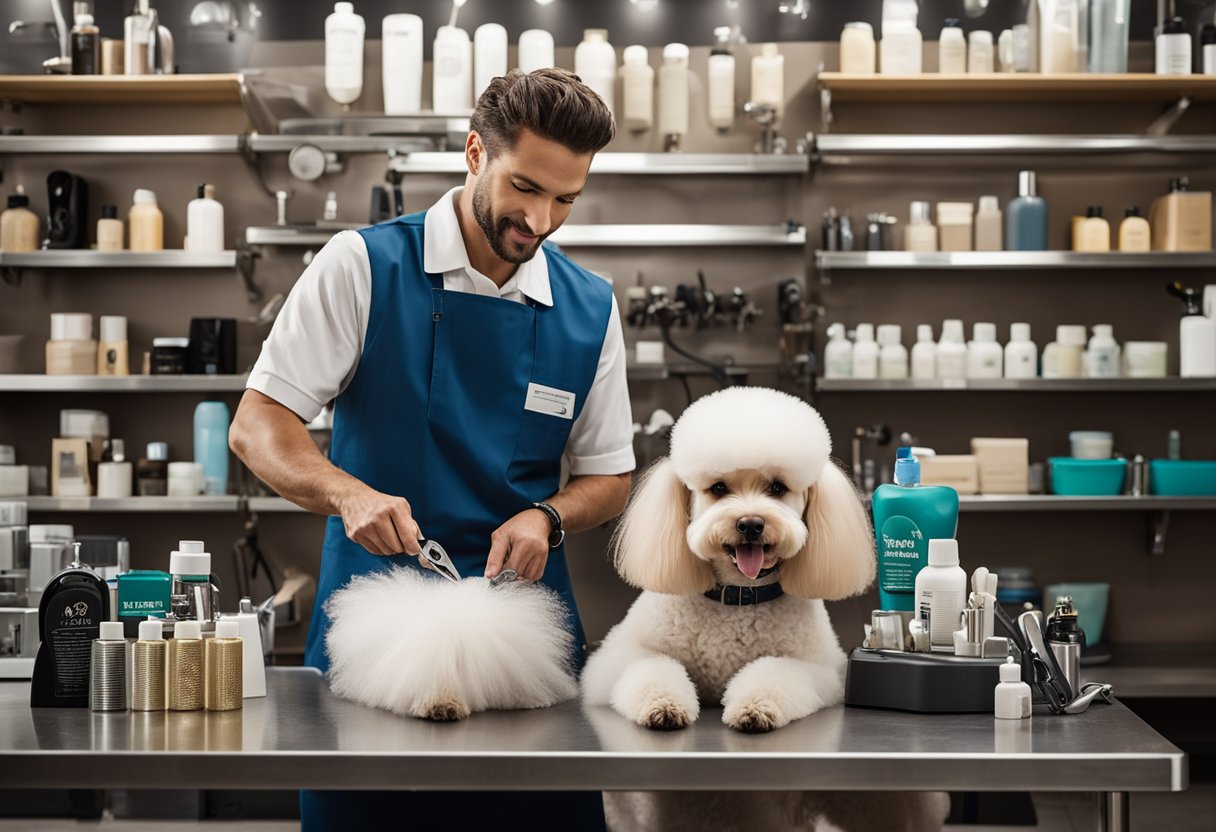
How often should a dog be professionally groomed?
The frequency of professional grooming depends on the breed, coat type, and lifestyle of your dog. Dogs with longer hair or those that shed heavily may need grooming every 4-6 weeks, while shorter-haired dogs may only need grooming every 8-12 weeks. Dogs that spend a lot of time outdoors or are very active may need more frequent grooming to keep their coats clean and healthy.
What are the typical services included in dog grooming?
A typical dog grooming session includes a bath, blow-dry, brushing, nail trimming, and ear cleaning. Some groomers may also offer additional services, such as teeth cleaning, anal gland expression, and haircuts.
How do I choose the right groomer for my dog?
When choosing a groomer for your dog, it’s important to do your research. Look for a groomer with experience and a good reputation. You can ask for recommendations from friends or your veterinarian. It’s also a good idea to visit the grooming salon before your appointment to make sure it’s clean and well-maintained. Finally, make sure the groomer is willing to work with you to meet your dog’s specific needs.
Can dog grooming help with shedding?
Regular grooming can help reduce shedding by removing loose hair and preventing mats and tangles. Brushing your dog’s coat regularly can also distribute natural oils, which can help keep the coat healthy and shiny.
What should I do to prepare my dog for grooming?
Before your dog’s grooming appointment, make sure they are up-to-date on all their vaccinations. It’s also a good idea to give your dog a quick brush to remove any loose hair or mats. Finally, make sure your dog has had a chance to go outside to relieve themselves before their appointment.
Are there any breed-specific grooming considerations I should be aware of?
Different breeds of dogs have different grooming needs. For example, dogs with long hair, such as Shih Tzus or Poodles, may need more frequent grooming to prevent mats and tangles. Breeds with shorter hair, such as Beagles or Boxers, may only need occasional brushing. It’s important to research your dog’s specific breed to determine their grooming needs.
REFERENCES
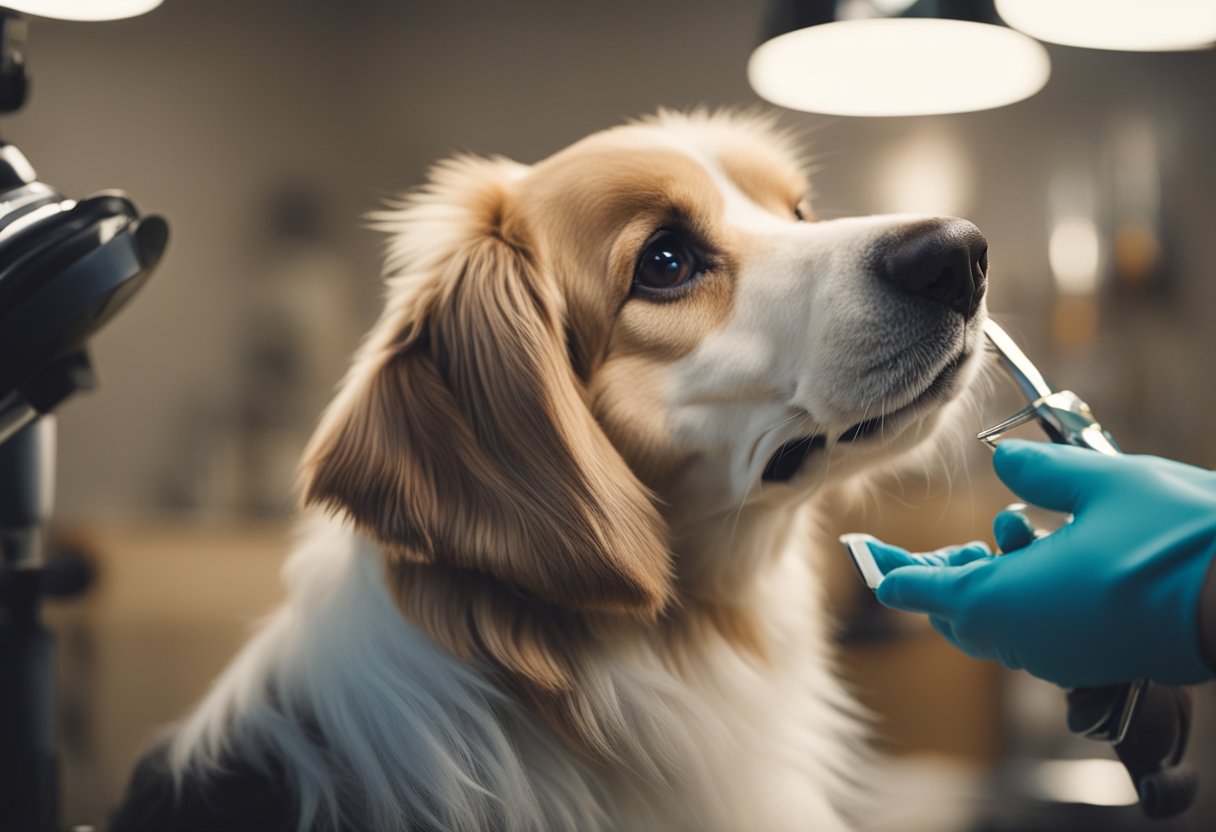
If you’re interested in learning more about dog grooming, there are plenty of resources available online. Here are a few external links that you may find helpful:
- American Kennel Club: The AKC is a great resource for all things dog-related, and they have a section dedicated to grooming. You’ll find articles on everything from how to groom a specific breed to tips for bathing your dog.
- Rover.com: Rover.com is a website that connects dog owners with dog sitters and walkers, but they also have a blog with tons of helpful articles. Their dog grooming 101 guide is a great place to start if you’re new to grooming.
- Best Friends Animal Society: Best Friends Animal Society is a non-profit organization that works to save animals in shelters across the country. They have a great article on dog grooming tips that covers everything from brushing to nail trimming.
In addition to these external resources, there are also plenty of books and videos available on dog grooming. If you’re interested in a more in-depth look at grooming, you may want to check out some of these resources as well.
Remember, grooming is an important part of your dog’s overall health and wellbeing. By taking the time to learn how to groom your dog properly, you can help keep them looking and feeling their best.
